
Epinotia nanana, the European spruce needleminer, is a moth of the family Tortricidae. It is found from northern and central Europe to Russia and Mongolia.

Epinotia nisella is a moth of the family Tortricidae which is found in the Palearctic, Europe and North America. It was first described by Carl Alexander Clerck in 1759.

Grapholita compositella, the clover seed moth, is a moth of the family Tortricidae. It is found from Europe to Asia Minor, Mongolia, China and eastern Russia. It is also present in North America.
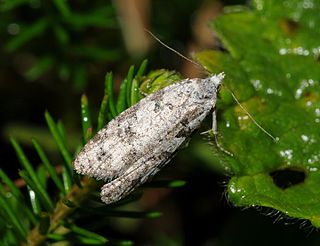
Eana penziana, or Pentz's tortrix, is a moth of the family Tortricidae. It is found in most of Europe, east to the eastern part of the Palearctic realm. It is also found in the Near East.

Olethreutes palustrana is a moth of the family Tortricidae. It is found in most of Europe, except the Iberian Peninsula and the Balkan Peninsula. It is also known from the eastern part of the Palearctic realm and North America. The habitat consists of heathland with scattered trees.
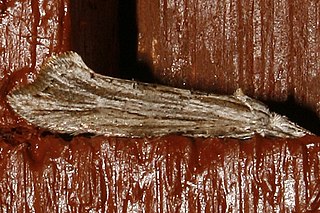
Ypsolopha falciferella is a species of moth in the family Ypsolophidae first described by Lord Walsingham in 1881. It is found throughout much of North America, including British Columbia, Alberta, Manitoba, Saskatchewan, Michigan and Maryland. It is known from a wide variety of habitats, including mixed wood forests, riparian habitats and semi-arid scrubland.
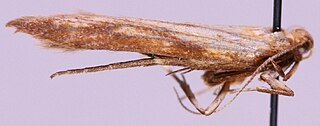
Metzneria neuropterella, the brown-veined neb, is a moth of the family Gelechiidae. It is found from most of Europe to the southern Ural Mountains, the Caucasus, southern and south-eastern Siberia and Mongolia, as well as in North Africa. The habitat consist of short-turfed, herb rich chalk downland.

Isotrias rectifasciana, the hedge shade, is a species of moth of the family Tortricidae found in Asia and Europe. The moth was first described by the English entomologist, Adrian Hardy Haworth in 1811.

Gynnidomorpha alismana, the water plantain conch, is a moth of the family Tortricidae. It was described by Ragonot in 1883. It is found in most of Europe, except Spain, Switzerland, most of the Balkan Peninsula and Ukraine. Further east it is found across the Palearctic to China and Korea. It is found in riverine and other watery habitats.
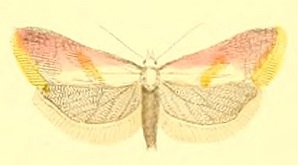
Cochylis flaviciliana, the gold-fringed conch, is a moth of the family Tortricidae. It was described by Westwood in 1854. It is found in most of Europe and north-western Africa. The habitat consists of chalky grasslands.

Eana osseana, common name dotted shade, is a moth of the family Tortricidae.
Archips alberta is a species of moth of the family Tortricidae first described by James Halliday McDunnough in 1923. It is found in North America, where it has been recorded across boreal Canada, south through the mountains to Utah. The habitat consists of coniferous forests.
Archips eleagnanus is a species of moth of the family Tortricidae first described by James Halliday McDunnough in 1923. It is found in North America, where it has been recorded from Alberta, Manitoba, Saskatchewan, Wyoming and New Mexico. The habitat consists of prairies and montane areas.
Argyrotaenia occultana, the fall spruce needle moth, is a moth of the family Tortricidae. The species was first described by Thomas Nesbitt Freeman in 1942. It is found in North America, where it has been recorded from British Columbia north to Yukon and Northwest Territories, east to Newfoundland and south to Kentucky and Oregon. The habitat consists of spruce forests.
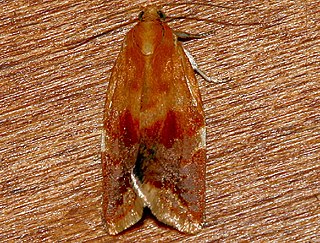
Clepsis persicana, the white triangle tortrix or the green needleworm, is a species of moth of the family Tortricidae. It is found in North America, where it has been recorded from Alaska and British Columbia to Newfoundland and south to Virginia and west to California. The habitat consists of coniferous and mixed coniferous forests.
Pandemis canadana, the green aspen leaftier, is a moth of the family Tortricidae. The species was first described by William D. Kearfott in 1905. It is found in North America, where it has been recorded from British Columbia to Nova Scotia, south to Colorado, Illinois and Maine. The habitat consists of deciduous forests and shrubs.
Pandemis pyrusana, the apple pandemis or pandemis leafroller moth, is a species of moth of the family Tortricidae. The species was first described by William D. Kearfott in 1907. It is found in North America, where it has been recorded from Alberta to British Columbia, south through Idaho, Utah and Colorado and California. The habitat consists of forests with deciduous trees and shrubs.

Periclepsis cinctana, the Dover twist, is a species of moth of the family Tortricidae found in Europe. It was first described by Michael Denis and Ignaz Schiffermüller in 1775.

Acleris lipsiana is a species of moth of the family Tortricidae. It is found in Great Britain, Spain, France, Belgium, the Netherlands, Germany, Denmark, Austria, Switzerland, Italy, the Czech Republic, Slovakia, Hungary, Poland, Greece, Norway, Sweden, Finland, the Baltic region and Russia. It is also found in North America, where it has been recorded from Alberta and Washington. The habitat consists of high moors and mountainous areas.

Endothenia hebesana, the verbena bud moth, is a species of moth of the family Tortricidae. It is found in North America, where it has been recorded from Massachusetts, New York, New Jersey, Pennsylvania, Maryland, Virginia, North Carolina, Florida, Texas, Ohio, Indiana, Missouri, California, British Columbia, Alberta, Manitoba and Ontario. The habitat consists of black spruce-sphagnum bogs.















